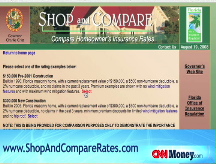The risk your home policy won't cover
It's not tomorrow's big natural disaster. It's getting hit by today's huge premium hikes. Here's how to fight.
(Money Magazine) -- As if it weren't bad enough that home prices are going down (way down), the cost of homeowners insurance is also moving in the wrong direction: up (in some areas, way up).
And the worst increases aren't confined to the hurricane-ravaged Gulf region. Just ask Paula Aschettino, who lives on Cape Cod, Mass., which hasn't seen a major storm since 1991. Yet in the past two years, her premium has jumped 50% to $4,800 a year.
"My increase in premiums is outrageous," says Aschettino. "Up here we just don't see that kind of damage."
Granted, not every homeowner has suffered premium hikes of that magnitude lately. The most dramatic increases, ranging from 20% to a whopping 100% over the past five years, are showing up in coastal areas.
But rates are also on the rise in midwestern states because of weather nasties like tornadoes and hailstorms. Missouri, for example, saw rates ratchet 40% higher after hailstorms caused $1.9 billion in damage in 2001.
The good news: There are steps you can take to lower your premiums no matter where you live. But to devise your strategy, you first need to understand what's behind the price hikes and how insurers are changing the rules of the game.
On the face of it, the reason for higher premiums is obvious: bad weather, lots of it. In 1992, Hurricane Andrew inflicted about $25 billion in damage on South Florida, $15.5 billion of which came out of insurers' pockets.
A hurricane the size of Andrew was supposed to happen only once every few decades, but nobody told that to Katrina, Wilma, Gustav and Ike. All caused billions in damage.
The financial hit led insurers to devise new ways to assess their risk. Under the old method, they calculated the odds of a major storm based on 30 to 100 years of weather history.
But one by one, companies have switched to a model that instead focuses on the past five years - a period of intense hurricane activity. Not surprisingly, that puts a much higher probability on the Big One striking - somewhere, sometime soon. Up and away go the rates.
Consumer advocates, though, aren't buying the new methodology. Insurers' models, they say, are supposed to spread risk out over long periods, keeping premiums steady through both calm and turbulent times. Shifting to such short-term history as a basis for rates, they argue, is a bit like adjusting a baseball player's salary based on his past five games.
"Insurers came after Hurricane Andrew with new models and said, 'Trust us, we know what we're doing now,' " says Birny Birnbaum, executive director of the Center for Economic Justice, a nonprofit consumer advocacy group.
But after a few storms they were back for more rate increases. "That doesn't make sense," he says. Regulators increasingly agree and often turn down insurance company requests for big rate increases.
But when commissioners hold the line, that can lead to a different problem. Rather than write policies at the lower rates, some carriers simply stop serving the area.
Since 2004, for example, Allstate has written 500,000 fewer policies in Florida. State Farm has virtually stopped writing new policies there and is not renewing wind policies for homeowners who live within a mile or so of the beach.
As a result, instead of many insurers competing for your business and keeping rates in check, you might have only one, which charges you as if you're Donald Trump - or even worse, no private insurers at all.
Most states sponsor backup insurers that will issue a policy if no private insurer will, but their rates are usually among the highest. Some insurers, regulators and lawmakers are pushing for a federal program to back insurers if a mega-catastrophe does strike, and that could bring rate relief. But there's no indication if or when it will pass.
Send feedback to Money Magazine



